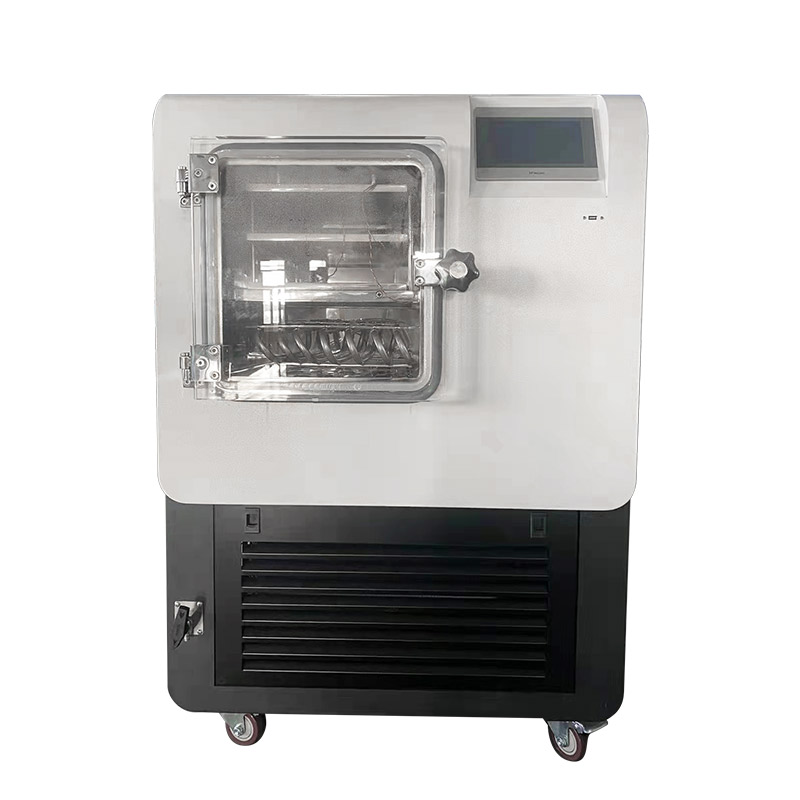Fruits, vegetables, meats, cheeses, candy and other foods can successfully be freeze-dried and stored without the need for refrigeration.
Kitchen appliances come and go over time. The once-popular George Forman grill is now a regular garage sale item. Instant Pot was the trendiest appliance on the countertop not long ago before moving over to make room for air fryers. Personal Freeze Dryer Machine

Freeze dryers for the home are gaining more interest lately.
While pharmaceutical companies and large food manufacturers have been taking advantage of this food preservation method for years, the hefty price tag prohibited widespread popularity for individual households until now.
“Now that there are Harvest Right freeze dryers that can be fairly economical for purchase, there’s been a lot more questions about freeze drying,” said Mary-Grace Danao, food engineer by training and extension specialist with the University of Nebraska-Lincoln (UNL).
UNL responded to the increased curiosity about freeze drying by holding a professional development day in May for extension educators to learn more about the process. Moreover, a guide of “best practices” for freeze drying at home will be released this fall for online access by the public, Danao said.
Some foods keep better if sealed with a desiccant packet to absorb moisture for long-term storage.
Part of the attraction to freeze drying is that more people want to make their own food. Also, freeze-dried foods help with emergency preparedness. Freeze-dried snacks and even prepared meals can be preserved for long-term storage without refrigeration, then eaten as is or reconstituted. Harvest Right, a main manufacturer of freeze dryer machines for the home, refers to freeze drying as the “provident food storage.”
From a health perspective, freeze drying can capture nutrients, minerals and vitamins unlike other food preservation methods because the food is not subjected to high heat. Almost any food can be freeze-dried: fruits, vegetables, confectionary items, candy, dairy and meat, both raw and cooked.
Before investing in a freeze drying machine, here are some considerations based on research from universities and the first-hand trials of Kylee Schoen, owner of Wicked Good Foods out of Beatrice, Neb. Her business is the only company in Nebraska currently that is authorized to sell freeze-dried fruits, vegetables and candy.
The name says it all: freeze drying involves freezing then dehydrating the product through sublimation. Danao explained that sublimation is the act of converting solid ice into steam vapor without going through the liquid stage (water).
Freeze-dried food is more porous than oven-dried or dehydrated foods because sublimation leaves holes where water once occupied. These air pockets fill quickly with water when the food is rehydrated. Simply misting foods such as greens or some fruit with water is enough to reconstitute them, as found in a May 24 article from Pennsylvania State University (PSU).
Freeze drying machines must be placed on top of a sturdy counter or table to accommodate the draining tube.
Purchasing a Freeze Drying Machine
The size of the freeze drying machine depends on how much food you intend to process at one time. Freeze drying machines for the home range in size from a little larger than a microwave (processing 6 to 10 pounds fresh food per batch) to larger than a standard stovetop oven (40 to 50 pounds fresh food per batch).
Schoen said one case of fresh strawberries, which weighs about 8 pounds, results in five 1-ounce bags of freeze-dried strawberries. A bushel of peaches weighs 48 pounds; processing one bushel at 6-10 pounds per batch with a 24-hour processing time and three-hour defrost after each batch would take over a week, as stated by an article published by Utah State University (USU).
Current prices for Harvest Right home freeze dryers are $2,495 for the small model up to $5,295 for the extra-large model. Cost of electricity to run the machine, as well as purchasing the packaging materials for long-term storage, should be considered in the overall cost.
Set-up and Maintenance of the Machine
The freeze drying machine must be elevated to accommodate the ice melting tube drain. Because home machines weigh anywhere from 90 to more than 250 pounds, a sturdy table or countertop is recommended. Also, a 110-volt outlet with one dedicated 20-amp circuit is required.
Choose a location with plenty of ventilation because the vacuum produces heat. Most freeze drying machines are equipped with a vacuum pump, said Danao. Keep in mind that the noise level is similar to a vacuum cleaner. It is recommended that the machine is placed in a convenient location so that you can continually monitor the freeze dryer during the 20 to 80-hour process.
Maintenance of freeze drying machines involves replacing the pump oil every 20-30 batches, although there are oil-free models available.
Foods that do not contain much moisture will not shrink too much during the freeze-drying process. Those foods with a high sugar content will actually expand.
Preparing Foods for Freeze Drying
Prepare food as for freezing, according to PSU. Fruits should be pretreated to prevent browning and vegetables blanched to stop the enzymes from breaking down food. The freeze-drying manufacturer Harvest Right says that foods can be freeze-dried raw or cooked, but “if you plan to rehydrate your vegetables, we’ve found that blanching them beforehand will help bring them back to that perfect texture.”
Meat, poultry and eggs can be freeze dried raw or cooked. Freeze drying does not cook the food, so all raw meat or poultry products must be cooked to proper internal temperature before consuming.
Bacteria is not killed while freeze drying because there is no heat-treatment during the cycle. Microorganisms remain viable but dormant, according to USU. An on-going study at Moscow State University in Russia is further analyzing if these dormant microorganisms can be rehydrated again after 50 years of storage.
Foods should be cut into similar-size pieces for even processing. Danao recommends slicing foods to maximize surface area.
“The more area all the water can escape from, the faster your freeze drying will take place,” said Danao.
Some foods expand during freeze drying, so it’s important to cut them into smaller pieces. Schoen said that she cuts Jolly Ranchers into one-fourths, otherwise, they expand and hit the top of the tray above.
“Anything with sugar and no moisture basically explodes,” Schoen said. “Anything with moisture will shrink but retains its shape.”
Once properly pre-treated and cut, food should be placed in a single layer on the freeze drying trays. Evenly space out the food and be aware of those foods prone to expansion.
Chilling or pre-freezing foods before freeze drying can significantly reduce processing time and produce a safer product. Schoen pre-freezes all foods except candy for 24 hours.
Pre-treating fruits prior to freeze drying may help them maintain a fresher appearance.
After placing the trays in the freeze dryer chamber, monitor the machine frequently. As the temperature goes down, you may notice a layer of “frost” on the food. The vacuum pump pulls air out of the chamber, speeding up the freezing process, Danao said. The machine drops to a temperature between -30 degrees and -50 degrees Fahrenheit, as stated by PSU.
Sublimation occurs when the trays heat, still under pressure from the vacuum, to no higher than 70 degrees Fahrenheit, said Danao. As water vapor is sucked out of the chamber, 90 to 95% of the water content is removed from the food.
The length of each cycle depends on the food being freeze-dried. Schoen said that an item without much moisture, such as confetti brownies, completes a cycle in 24-28 hours. Peaches and pineapple require 40 to 80 hours. “We’ll run everything an extra 24 hours to ensure it is dry,” Schoen said. The machine must defrost for two to three hours in between cycles, as well.
Owning a freeze dryer for home use alone may not be feasible, but freeze drying as a side business could help cover the cost.
Freeze-dried candy is a fad right now. You may be tempted to buck the trend and try freeze drying an innovative product; be aware of the state laws in Nebraska regarding selling food made at home. Nebraska Extension’s Mary-Grace Danao explained the Cottage Food Law for entrepreneurs who want to freeze dry more than just candy.
“Any product that enters the freeze dryer must be shelf-stable—no ingredient that requires refrigeration,” said Danao.
This limits what can be sold legally because sliced fruit and vegetables, perishable baked goods, meats, seafood, poultry products and dairy products must be refrigerated.
If you do not have a licensed, inspected commercial kitchen, you can only sell freeze-dried candy or certain pastries. Danao gave the examples of pre-made Twinkies and doughnuts.
Danao recommends that people reach out UNL with questions about freeze drying foods to sell in Nebraska.
“If you are seeking guidance from outer sources or universities, they might not know Nebraska laws,” said Danao.
The shelf life of freeze dried products varies based on what it is and how it is stored. While properly freeze-dried food can be considered “food safe” for years, the quality of the products decreases over time.
Freeze dryer manufacturing companies and internet sources claim that freeze dried food will last up to 25 years. However, UTU states that “no real data exists on the shelf-life of home freeze-dried products, because the company that invented and manufactured the first home freeze-dryer began sales in 2013.”
Furthermore, the presence of fat in products such as raw or cooked meats, dairy, poultry and eggs can quickly become rancid under freeze-drying conditions. The shelf-life of these products is much shorter.
“Freeze drying usually exacerbates lipid oxidation, the process that makes food go rancid,” Danao said.
Prolong the shelf-life of freeze dried food products by storing them in a cool, dry place without exposure to light in air-tight containers. A zip-top bag is acceptable if storing for up to a few months. The following recommendations from PSU are better options for long-term storage:
• Glass canning jars (for longer storage, remove air with vacuum sealer or add oxygen absorber)
• Metal cans (long-term storage but cannot be resealed)
• Vacuum packed bags (mid-term storage since water and oxygen can still pass through bags)
• Mylar bags (long-term storage in multilayer, metalized bags; add oxygen absorber and heat-seal closed)
Freeze drying food at home is gaining traction as home freeze dryer machines become more accessible. If the trend continues, freeze-dried food could be as revolutionary as sliced bread.
For more information about freeze drying at home, contact your local extension office.
Utah State University: https://extension.usu.edu/preserve-the-harvest/research/buying-a-home-freeze-dryer-what-to-know-before-you-go
Pennsylvania State University: https://extension.psu.edu/lets-preserve-freeze-drying
Reporter Kristen Sindelar has loved agriculture her entire life, coming from a diversified farm with three generations working side-by-side in northeastern Nebraska. Reach her at Kristen.Sindelar@midwestmessenger.com.
Get local news delivered to your inbox!
Email notifications are only sent once a day, and only if there are new matching items.
Producers need to revisit the strategies they’ve been deploying around farm finances, the use of farm debt, and their cash flow.
Fruits, vegetables, meats, cheeses, candy and other foods can successfully be freeze-dried and stored without the need for refrigeration.
Some foods keep better if sealed with a desiccant packet to absorb moisture for long-term storage.
Freeze drying machines must be placed on top of a sturdy counter or table to accommodate the draining tube.
Foods that do not contain much moisture will not shrink too much during the freeze-drying process. Those foods with a high sugar content will actually expand.
Pre-treating fruits prior to freeze drying may help them maintain a fresher appearance.

Small Freeze Dryer For Home Use Get up-to-the-minute news sent straight to your device.